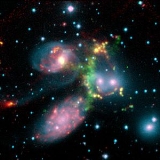
NGC 7318
Encyclopedia
NGC 7318 are a set of galaxies about 300 million light-year
s away in the Constellation
Pegasus
. They are a member of the famous Stephan's Quintet
, these galaxies are in the process of colliding
.
The Spitzer Space Telescope
revealed the presence of a huge intergalactic shock wave, shown by the magnificent green arc in the picture at right produced by one galaxy falling into another at millions of miles per hour. As NGC 7318B collides with NGC 7318A, gas spread throughout the cluster, atoms of hydrogen are heated in the shock wave, producing the green glow. The molecular hydrogen seen here is one of the most turbulent forms of molecular hydrogen ever seen. This phenomenon was discovered by an international team of scientists of the Max Planck Institute for Nuclear Physics
(MPIK) in Heidelberg. Most notable is the fact that this collision can help provide a view into what happened in the early universe 10 billion years ago when it formed.
Light-year
A light-year, also light year or lightyear is a unit of length, equal to just under 10 trillion kilometres...
s away in the Constellation
Constellation
In modern astronomy, a constellation is an internationally defined area of the celestial sphere. These areas are grouped around asterisms, patterns formed by prominent stars within apparent proximity to one another on Earth's night sky....
Pegasus
Pegasus (constellation)
Pegasus is a constellation in the northern sky, named after the winged horse Pegasus in Greek mythology. It was one of the 48 constellations listed by the 2nd century astronomer Ptolemy, and remains one of the 88 modern constellations.-Stars:...
. They are a member of the famous Stephan's Quintet
Stephan's Quintet
Stephan's Quintet in the constellation Pegasus is a visual grouping of five galaxies of which four form the first compact galaxy group ever discovered. The group was discovered by Édouard Stephan in 1877 at Marseilles Observatory....
, these galaxies are in the process of colliding
Interacting galaxy
Interacting galaxies are galaxies whose gravitational fields result in a disturbance of one another. An example of a minor interaction is a satellite galaxy's disturbing the primary galaxy's spiral arms. An example of a major interaction is a galactic collision.-Satellite interaction:A giant...
.
The Spitzer Space Telescope
Spitzer Space Telescope
The Spitzer Space Telescope , formerly the Space Infrared Telescope Facility is an infrared space observatory launched in 2003...
revealed the presence of a huge intergalactic shock wave, shown by the magnificent green arc in the picture at right produced by one galaxy falling into another at millions of miles per hour. As NGC 7318B collides with NGC 7318A, gas spread throughout the cluster, atoms of hydrogen are heated in the shock wave, producing the green glow. The molecular hydrogen seen here is one of the most turbulent forms of molecular hydrogen ever seen. This phenomenon was discovered by an international team of scientists of the Max Planck Institute for Nuclear Physics
Max Planck Institute for Nuclear Physics
The Max-Planck-Institut für Kernphysik is aresearch institute in Heidelberg, Germany.The institute is one of the 80 institutes of the Max-Planck-Gesellschaft , an independent, non-profit research organization. The Max Planck Institute for Nuclear Physics has been founded in 1958 under the...
(MPIK) in Heidelberg. Most notable is the fact that this collision can help provide a view into what happened in the early universe 10 billion years ago when it formed.
External links
- Hickson 92 in Pegasus
- SIMBAD: VV 288 -- Interacting Galaxies
- http://simbad.u-strasbg.fr/sim-id.pl?protocol=html&Ident=NGC+7318B&NbIdent=1&Radius=10&Radius.unit=arcmin&CooFrame=FK5&CooEpoch=2000&CooEqui=2000&output.max=all&o.catall=on&output.mesdisp=N&Bibyear1=1983&Bibyear2=2006&Frame1=FK5&Frame2=FK4&Frame3=G&Equi1=2000.0&Equi2=1950.0&Equi3=2000.0&Epoch1=2000.0&Epoch2=1950.0&Epoch3=2000.0SIMBAD: UGCUppsala General CatalogueThe Uppsala General Catalogue of Galaxies is a catalogue of 12921 galaxies visible from the northern hemisphere. It was published the first time in 1973....
12100 -- Interacting Galaxies]

